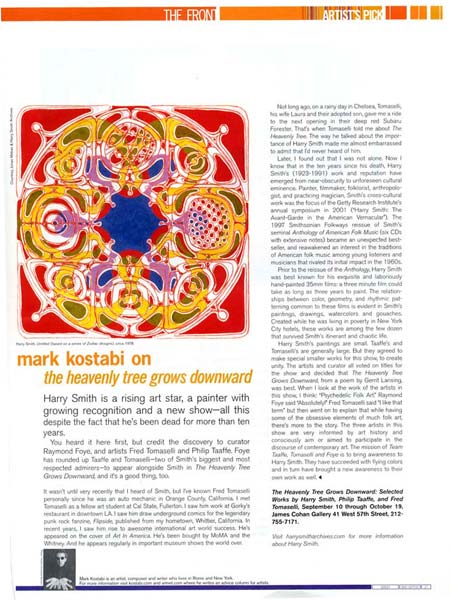Mark Kostabi on The Heavenly Tree Grows Downward

Harry Smith is a rising art star, a painter with growing recognition and a new show-all this despite the fact that he’s been dead for more than ten years. You heard it here first, but credit the discovery to curator Raymond Foye, and artists Fred Tomaselli and Philip Taaffe. Foye has rounded up Taaffe and Tomaselli-two of Smith’s biggest and most respected admirers-to appear alongside Smith in the Heavenly Tree Grows Downward, and it’s a good thing, too.
It wasn’t until very recently that I heard of Smith, but I’ve known Fred Tomaselli personally since he was an auto mechanic in Orange County, California. I met Tomaselli as a fellow art student at Cal State, Fullerton. I saw him work at Gorky’s restaurant in downtown LA. I saw him draw underground comics for the legendary punk rock fanzine, Flipside, published from my hometown, Whittier, California. In recent years, I saw him rise to awesome international art world success. He’s appeared on the cover of Art In America. He’s been bought by MoMA and the Whitney. And he appears regularly in important museum shows the world over.
Not long ago, on a rainy day in Chelsea, Tomaselli, his wife Laura and their adopted son, gave me a ride to the next opening in their deep red Subaru Forester. That’s when Tomaselli told me about The Heavenly Tree. The way he talked about the importance of Harry Smith made me almost embarrassed to admit that I’d never heard of him.
Later, I found out that I was not alone. Now I know that in the ten years since his death, Harry Smith’s (1923-1991) work and reputation have emerged from near-obscurity to unforeseen cultural eminence. Painter, filmmaker, folklorist, anthropologist, and practicing magician, Smith’s cross-cultural work was the focus of the Getty Research Institute’s annual symposium in 2001 (“Harry Smith: The Avant-Garde in the American Vernacular”). The 1997 Smithsonian Folkways reissue of Smith’s seminal Anthology of American Folk Music (six CDs with extensive notes) became an unexpected bestseller, and reawakened an interest in the traditions of American folk music among young listeners and musicians that rivaled its initial impact in the 1960s.
Prior to the reissue of the Anthology, Harry Smith was best known for his exquisite and laboriously hand-painted 35mm films: a three minute film could take as long as three years to paint. The relationships between color, geometry, and rhythmic patterning common to these films is evident in Smith’s paintings, drawings, watercolors and gouaches. Created while he was living in poverty in New York City hotels, these works are among the few dozen that survived Smith’s itinerant and chaotic life.
Harry Smith’s paintings are small. Taaffe’s and Tomaselli’s are generally large. But they agreed to make special smaller works for this show, to created unity. The artists and curator all voted on titles for the show and decided that The Heavenly Tree Grows Downward, from a poem by Gerrit Lansing, was best. When I look at the work of the artists in this show, I think: ” Psychedelic Folk Art.” Raymond Foye said “Absolutely!” Fred Tomaselli said ” I like that term” but then went on to explain that while having some of the obsessive elements of much folk art, there’s more to the story. The three artists in this show are very informed by art history and consciously aim or aimed to participate in the discourse of contemporary art. The mission of Team Taaffe, Tomaselli and Foye is to bring awareness to Harry Smith. They have succeeded with flying colors and in turn have brought a new awareness to their own works as well.
The Heavenly Tree Grows Downdward: Selected Works by Harry Smith, Philip Taaffe, and Fred Tomaselli, September 10 through October 19, James Cohan Gallery 41 West 57th Street, 212-755-7171
August-September 2002